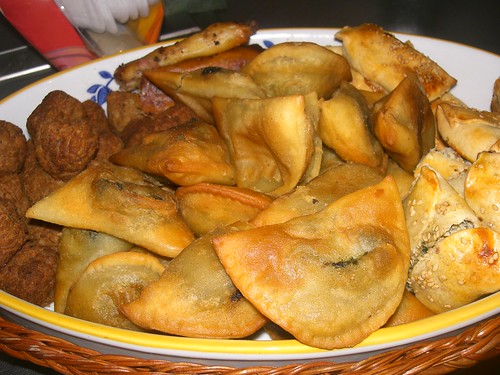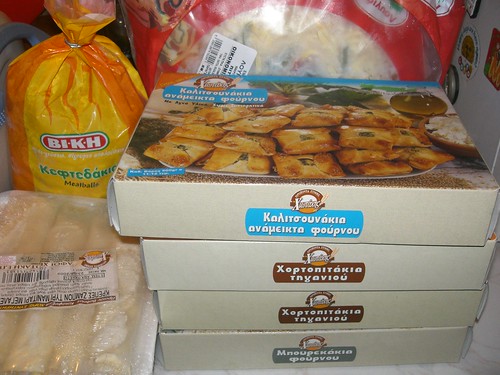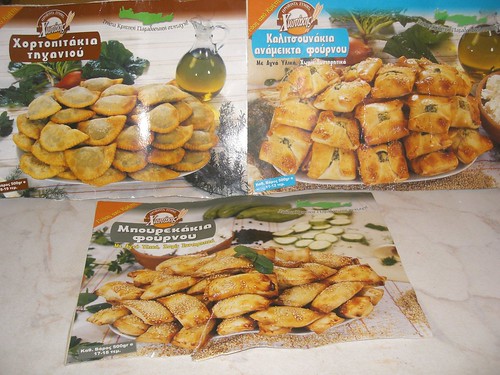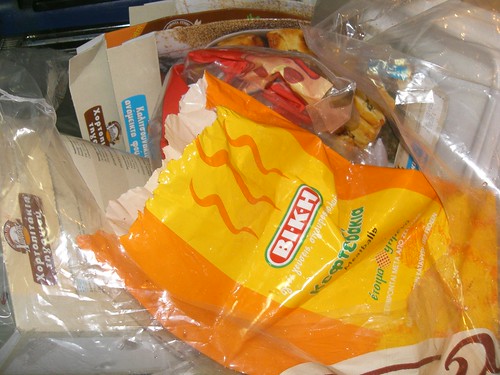Party food in Hania nearly always includes locally made traditional pastries, kalitsounia, stuffed with various savoury fillings. This was our prime consideration when we had to choose from the myriad of packets available in the supermarket deep freeze. Priority was also given to easy-to-handle finger food, to the exclusion of sauce-based food. Our final choices were nearly all locally produced; this should not be a surprise, as the whole of Greece specialises in their own regional cuisine. There are many standard national favorites (eg bifteki, dolmades, kalamari), but in a place like Crete, with an abundance of wild greens and all kinds of other produce, there are also many dishes that are unique, not only to the island, but even to one particular area of the island. They are considered standard fare, and are mass-produced for busy people: no one can imagine a wedding without xerotigana, nor an Easter without kalitsounia, for instance, but we don't all make these delicacies ourselves.
Our final choice for μεζεδάκια - mezedakia (appetisers) included the following: kalitsounia with greens, kalitsounia with spinach and mizithra, boureki pasties, locally-produced cheese crackers, locally produced pizzas and meatballs shipped from the mainland. Having never bought such snacks, the main method we employed in choosing what to buy came from the supposed appearance of the finished product on the packaging. We also checked the listed ingredients. I was always thought of packaged food products as unhealthy because they are bound to contain artificial colours, preservatives and other additives that we simply don't add to our food when we're cooking in our own kitchen. I was surprised by how few unknown non-kitchen ingredients most of them contained. All the products carried a 'use by' date well into 2009.
BIKY MEATBALLS: 6.06 euro/1kg
Of all our party food choices, the meatballs contained the most chemical additives. They were also the most clearly labelled, with a claim that 50% of their total ingredients contained meat. Most of the list contained ingredients you would normally find in meatballs: meat, pork fat, salt, egg, garlic, ginger, coriander, pepper, mint, parsley. From the range of spices listed these meatballs could substitute for pot pourri. Not that any of the herbs and spices could actually be seen or tasted. The labelling also stated that they were pre-cooked, needing only to be heated up for serving.Among the listed ingredients that do not belong in a home kitchen were 'aroma' (literally 'perfume'; some kind of flavour enhancer) and συντιριτικό 'sintiritiko' (preservative), as well as something that was abbreviated as 'galact.', obviously a product derived from milk, which could be included to bind the ingredients, add more bulk or create a softer texture. There was also something called 'soya protein', a source of fat in processed foods, carrying the claim that it was from a non-GMO source, as well as 'phosphoric salts', which must be quite different to the salt used in a home kitchen for it to be labelled as phosphoric.
Another ingredient which read strangely was 'MΔk kot.'; I have no idea what this might mean, unless the 'kot.' refers to κοτόπουλο 'kotopoulo' - chicken. If this is the case, then I suspect that the meatballs contained MRM: "mechanically recovered meat which is obtained by pushing the carcass through a giant teabag-like screen to produce a slurry of protein, which is then bound back together with polyphosphates and gums" (Felicity Lawrence, Not on the Label). Chicken skin, considered the most useless chicken meat, rather than being thrown away, is usually minced so finely that it becomes totally unrecognisable, and cannot be traced visually in a finished food product. Felicity Lawrence also reports that some chicken nugget brands are made entirely out of chicken skin, which lacks any kind of nutritional value whatsoever.
The meatballs were tasty - in that chicken nugget way that all junk food tastes. No effort was made on the part of the manufacturers in terms of shape: the meatballs weren't round. They were more like sliced chunks of mincemeat rolled into a sausage - somebody obviously could not be bothered to shape them properly. I hope I never need to buy this sort of food again for a long time.
Interestingly enough, the same company produces meatballs in different packaging (a tray instead of a bag; it looks more appealing), using the same ingredients, but without the chemical or non-kitchen ingredient additives, a discovery I made on my next visit to the supermarket. They also contained 'breadcrumbs' instead of 'wheat starch', which is made from a by-product of wheat kernels; in other words, it is a waste product used as an additive in food products, to mimic wheat. They are of course more expensive: 8.50 euro per kilo.
LOUGIAKIS PIZZAS: 8.08 euro/3 pieces, each yielding 8 standard pizza slices
There was nothing listed in the ingredients that sounded unusual: flour, salt, water, yeast (which is what I use to make pizza dough, with the addition of olive oil), edam, gouda, peppers, salami, ham and bacon. Generalised varieties of edam and gouda cheese, ham, bacon and salami are often found in the deli section of supermarkets; they are usually the cheapest kinds of sandwich fillings, and they are not all made in Greece. This shouldn't be a reason to shun them; some imported deli items are usually very tasty, such as Kerrygold regato cheese, a popular choice in Greece. A 'salsa' was also mentioned in the list of ingredients, but wasn't elaborated on. This seemed very dubious: surely the ingredients of the salsa should have been on the label. The labeling did not list any preservatives, colourings or other chemical additives.
There was nothing listed in the ingredients that sounded unusual: flour, salt, water, yeast (which is what I use to make pizza dough, with the addition of olive oil), edam, gouda, peppers, salami, ham and bacon. Generalised varieties of edam and gouda cheese, ham, bacon and salami are often found in the deli section of supermarkets; they are usually the cheapest kinds of sandwich fillings, and they are not all made in Greece. This shouldn't be a reason to shun them; some imported deli items are usually very tasty, such as Kerrygold regato cheese, a popular choice in Greece. A 'salsa' was also mentioned in the list of ingredients, but wasn't elaborated on. This seemed very dubious: surely the ingredients of the salsa should have been on the label. The labeling did not list any preservatives, colourings or other chemical additives.
My husband commented that the cooked product did not smell 'stale' or 'rotten', as when deli items are not very fresh, or they have been subjected to temperature extremes. This does not surprise me: the pizzas were made by a company whose premises are 100 metres away from the supermarket the product was bought from. They spent very little time in transit, which proves that buying local is often a more efficient choice than sourcing organic, which may be more time-consuming and distant.
I have tasted other pizza brands, but this was the tastiest I'd ever had of store-bought pizzas. Our guests thought so too. They had an almost home-made flavour to them; it's a pity that some of the ingredients could not be deduced.
TSATSARONAKIS CHEESE CRACKERS: 1.44 euro/150g
The crackers were made by a local bakery, and again, no mention was made of chemical additives. The recipe sounded simple: flour, tomato juice, olive oil, yeast, salt and locally-produced graviera cheese. My only reservation was that these crackers were not tasty on their own; they needed to be paired with some olives and a piece of cheese, or some tzatziki. It was no surprise that they did not prove to be very popular. They made a great accompaniment to our meals later in the week, especially with bean stews.
greens pasties: 3.93 euro/18 pieces - 2 packets
cheese and spinach pasties: 4.10 euro/12 pieces
boureki pasties: 3.93/18 pieces
filled crepes: 3.76/5 pieces - 2 packets (halved to produce 10 pieces per packet)
These pastries were probably the most delicious pret-a-manger appetiser I have eaten in a long time. Everyone remarked on how home-made they looked and tasted. These pastry goods are traditionally made by most mothers and grandmothers throughout the whole province of Hania. The ingredient contents were very wholesome, listing food items that are commonly found in a home kitchen: flour, oil, salt, pepper, mizithra (Cretan soft white cheese) and greens. They were also the only items that included an English translation of the ingredients. The labelling insists: "only fresh ingredients, no preservatives." I'm willing to believe this, as the taste of these products was almost as good as the home-made versions.
The pies only stood out as industrially produced from their uniform size: all the pieces were made in the same shape in the same dimensions. The spinach and cheese kalitsounia did not hold their shape well after they were cooked (in the oven, as with the boureki pies, brushed with egg and sprinkled with sesame seed); they had a heavy look to them, possibly because there was too much mixture for the pastry shell. The same could be said for the crepes (fried); they too felt heavy and were prone to disintegrating from the weight of the mixture and the frying process. The boureki pies and horto-kalitsouna came out practically perfect.
My main reservation with mass-produced food is that I don't feel comfortable eating something that is made in an industrial kitchen. This kind of food should be reserved for desperate times, and eaten very infrequently. Product labelling is not as simple as it sounds. Most of the time, we find listed ingredients whose appearance, taste and smell are completely unknown to us. Even if we are told that what is in the product we are buying, we don't really know what is in it. Those unknown ingredients are never normally found in a home kitchen.
What surprised me most about my choice in ready-to-cook party food was how cheap it was to buy, compared to making these delicacies myself. The ingredients would have cost me approximately the same amount of money to buy and prepare this food at home, but I would have remained unpaid for my effort to produce them... No wonder people go for this sort of food when time is pressing.
It was obvious that industrially produced local food was superior to industrial food produced elsewhere. Local food technicians know what their fellow citizens want to eat, and they have to try to maintain a high standard. They also use local ingredients, sourced within a small distance away for the point where they will be manipulated, and where the final product will be sold. A town like Hania is very feudal in its solidarity to small enterprises; word will spread if their products are not high quality, and people will simply stop buying them, preferring another local brand. Cretan cuisine in particular is well-known all over Greece; quality cannot be compromised if a local business wants to compete with a mainland giant producer for a similar product.
Another problem arose after I started opening up the packaged products. My kitchen benchtop suddenly began overflowing with paper and plastic. Never in my life have I had to amass so much throwaway packaging, coming straight out of my kitchen. It's all very well to talk about recycling paper and plastic, but surely not this kind of quantity from food products. So much care is taken to package products, not only to stop them from decomposing, but also to maintain shape and texture. Appearance is the all-important consideration here.
How much can you eat of this stodge? As the host for the night, I couldn't eat much myself. I was too busy 'entertaining' my guests. Even those few bits and pieces that I did eat made my stomach feel heavy. It could have been that I'm simply not used to eating pastry and fried food as a main meal. I was reminded of a visit to Pizza Hut with my family in London. All we ordered was a pizza, some oven-fried potatoes, a coleslaw and soft drink, shared among the family. Everything was very tasty, but why did our stomachs feel as though they were about to explode?
The crackers were made by a local bakery, and again, no mention was made of chemical additives. The recipe sounded simple: flour, tomato juice, olive oil, yeast, salt and locally-produced graviera cheese. My only reservation was that these crackers were not tasty on their own; they needed to be paired with some olives and a piece of cheese, or some tzatziki. It was no surprise that they did not prove to be very popular. They made a great accompaniment to our meals later in the week, especially with bean stews.
greens pasties: 3.93 euro/18 pieces - 2 packets
cheese and spinach pasties: 4.10 euro/12 pieces
boureki pasties: 3.93/18 pieces
filled crepes: 3.76/5 pieces - 2 packets (halved to produce 10 pieces per packet)
These pastries were probably the most delicious pret-a-manger appetiser I have eaten in a long time. Everyone remarked on how home-made they looked and tasted. These pastry goods are traditionally made by most mothers and grandmothers throughout the whole province of Hania. The ingredient contents were very wholesome, listing food items that are commonly found in a home kitchen: flour, oil, salt, pepper, mizithra (Cretan soft white cheese) and greens. They were also the only items that included an English translation of the ingredients. The labelling insists: "only fresh ingredients, no preservatives." I'm willing to believe this, as the taste of these products was almost as good as the home-made versions.
The pies only stood out as industrially produced from their uniform size: all the pieces were made in the same shape in the same dimensions. The spinach and cheese kalitsounia did not hold their shape well after they were cooked (in the oven, as with the boureki pies, brushed with egg and sprinkled with sesame seed); they had a heavy look to them, possibly because there was too much mixture for the pastry shell. The same could be said for the crepes (fried); they too felt heavy and were prone to disintegrating from the weight of the mixture and the frying process. The boureki pies and horto-kalitsouna came out practically perfect.
*** *** ***
My main reservation with mass-produced food is that I don't feel comfortable eating something that is made in an industrial kitchen. This kind of food should be reserved for desperate times, and eaten very infrequently. Product labelling is not as simple as it sounds. Most of the time, we find listed ingredients whose appearance, taste and smell are completely unknown to us. Even if we are told that what is in the product we are buying, we don't really know what is in it. Those unknown ingredients are never normally found in a home kitchen.
What surprised me most about my choice in ready-to-cook party food was how cheap it was to buy, compared to making these delicacies myself. The ingredients would have cost me approximately the same amount of money to buy and prepare this food at home, but I would have remained unpaid for my effort to produce them... No wonder people go for this sort of food when time is pressing.
It was obvious that industrially produced local food was superior to industrial food produced elsewhere. Local food technicians know what their fellow citizens want to eat, and they have to try to maintain a high standard. They also use local ingredients, sourced within a small distance away for the point where they will be manipulated, and where the final product will be sold. A town like Hania is very feudal in its solidarity to small enterprises; word will spread if their products are not high quality, and people will simply stop buying them, preferring another local brand. Cretan cuisine in particular is well-known all over Greece; quality cannot be compromised if a local business wants to compete with a mainland giant producer for a similar product.
Another problem arose after I started opening up the packaged products. My kitchen benchtop suddenly began overflowing with paper and plastic. Never in my life have I had to amass so much throwaway packaging, coming straight out of my kitchen. It's all very well to talk about recycling paper and plastic, but surely not this kind of quantity from food products. So much care is taken to package products, not only to stop them from decomposing, but also to maintain shape and texture. Appearance is the all-important consideration here.
How much can you eat of this stodge? As the host for the night, I couldn't eat much myself. I was too busy 'entertaining' my guests. Even those few bits and pieces that I did eat made my stomach feel heavy. It could have been that I'm simply not used to eating pastry and fried food as a main meal. I was reminded of a visit to Pizza Hut with my family in London. All we ordered was a pizza, some oven-fried potatoes, a coleslaw and soft drink, shared among the family. Everything was very tasty, but why did our stomachs feel as though they were about to explode?




Hi Maria, I'm trying to get caught up on your blog. It's been a crazy week! This was very informative. The part about chicken and wheat products made me wrinkle up my nose. Yuck. What struck me most about this post is your point about the packaging. It's ridiculous, isn't it? I'm always stunned at how everything is shrink wrapped, encased in cardboard, and then shoved into yet another plastic bag. Such waste! Great post as usual. I'm off to read your other entries!
ReplyDeleteHello. I agree about how informative this post about pre-packaged food is. I was horrified to learn about the chicken nugget processing--though thankfully no one in my house has a taste for them. We do our best to keep fresh, organic, homemade food available to our family. But here in NYC, we have a lot of choices in pre-packaged food (too many choices, maybe), and it's sometimes hard in our busy urban culture to completely avoid the purchase. I really related to your observation about how cheap some of these products are, and how inefficient it sometimes is to keep a kitchen full of homemade meals (time and money). It also reminds me of the time I realized that I was NOT saving money by hand-knitting sweaters for family and friends. The thing that always upsets me is how families from the low-economic classes in the city are the ones who often need the good nutrition most, and yet they are the most unfortunate victims of the packaged-food industry. Often, these needy families make "pop-culture"/unhealthy food choices because they do not have adequate resources to information--they do not have the same education about nutrition that others of us receive through good reading, access to nutritionists, etc.--but also there are some families who might know the difference, and yet they can only afford the can of sodium-, sugar-, and chemical preservative-laden stew or soup or other dish, because their local supermarket doesn't stock quality produce, or it's too expensive. Anyway, thanks for examining the issue. I find your posts are always really interesting. You're in a different part of the world, in a very different culture, but we're wrestling with the same things.
ReplyDeleteWow - so I've learned a lot...really!
ReplyDelete-DTW
www.everydaycookin.blogspot.com
Μπουκιά και συγχώριο όπως λέμε!
ReplyDeleteKalistounia - Shrink-wrapped, boxed, and made in a factory. I'm not sure if I should laugh or cry!
ReplyDeleteInformative post.We almost never buy pre-packed foods especially the ones with meat , too much fat , preservatives and additives.Even I feel bloated after eating a pizza outside,I guess its the fatty cheese and no whole grains that makes a fast food pizza so high in cals.
ReplyDelete